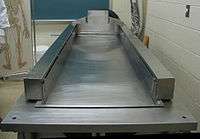List of instruments used in forensics
Instruments used in Forensics, including autopsy dissections are as follows: [1]
Instrument list
| Instrument | Uses |
|---|---|
| Autopsy table | for dissection of the corpse |
| CO2 | for preservation of the corpse |
| Dissection scissors | used to hold or move structures |
| Arterial & jugular tubes | to draw or drain out all the blood
before replacing it with embalming fluids like formaldehyde for preservation of structures as practiced in Anatomy |
| Head rest | to elevate the head |
| Restraint | to hold the corpse in place so that it does not change
position during dissection |
| Rubber gloves | to protect against infection, and to prevent contamination of evidence |
| Goggles | to protect against infection |
| Jackets, aprons, etc. | to protect against infection |
| Autopsy saws | to cut tough structures like bones |
| Blades | to cut the skin |
| Towel clamps | to hold towels in place |
| Skull breaker or often a (hammer and | to break open the vault of the skull |
| Bone saw | for cutting bones |
| Sternal saw | for cutting into the chest of the body by cutting
the sternum |
| Scalpel | sharp cutting instruments |
| Toothed forceps | for tearing or holding structures |
| Mallet | used as a hammer |
| Autopsy hammer | used just as a hammer |
| Skull key | a T-shaped chisel used as a lever while removing skull
cap[2] |
| Brain knife | to cleanly cut the brain |
| Rib shears | to cut through the ribs while opening the
chest[3] |
| Dissecting scissors | for sharp cutting |
| Speculum | for vaginal and rectal examinations |
| Non-absorbable sutures |
usually nylon to close the body cavities and sutures it |
| Postmortem needles | large thick needles for suturing the skin after
an autopsy to return the body to a natural looking state to prepare it for burial |
| Medical syringes | for fluid aspiration |
| Foley catheter | for evacuation or irrigation of the bladder to
collect a urine sample |
| Nasogastric tube | for nasogastric aspiration of stomach
contents; usually it is not used |
| Water bath | for flotation tests to detect presence of
gas, specially for infants (lungs, intestine) as a sign of postpartum life |
| Specimen jars/envelopes/packets | preservation of material evidence |
| Swabs | collecting smears |
| Metacarpal saw | video:
External link; a bone saw |
| Double-ended probe | used for probing |
| Tongue tie | to tie away the tongue so
that it doesn't fall back into to pharynx |
| Formaldehyde | primary preservative for Anatomy; video link |
| saturated Common salt solution / Rectified spirit | primary
preservative for Autopsy; video link |
| Osteometric board | to measure the length of (usually dried) bones |
| X-ray boxes | to view X-ray images |
| Fingerprint set | to collect fingerprints; video link |
Serological, chemical and genetic testings are done by the respective people of these branches.
Image gallery
-

Autopsy instruments
-

Autopsy instruments ( old set)
-

dissection table
References
- ↑ Visible Proofs: Forensic Vi ews forensic views the Body: Galleries: Exhibition Images: Upon a View of the Body
- ↑ http://www.keleka.net/deepbackground/resources/forensics/autopsy.htm Keleka
- ↑ Walker JE, Rutty GN, Rodgers B, Woodford NW (January 2002). "How should the chest wall be opened at necropsy?". J. Clin. Pathol. 55 (1): 72–5. doi:10.1136/jcp.55.1.72. PMC 1769557
 . PMID 11825931.
. PMID 11825931.